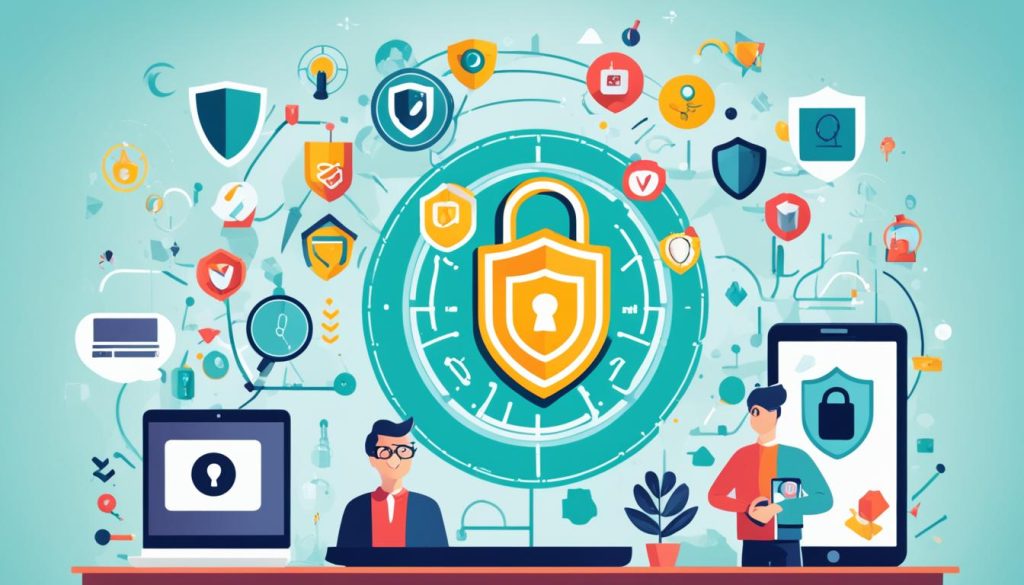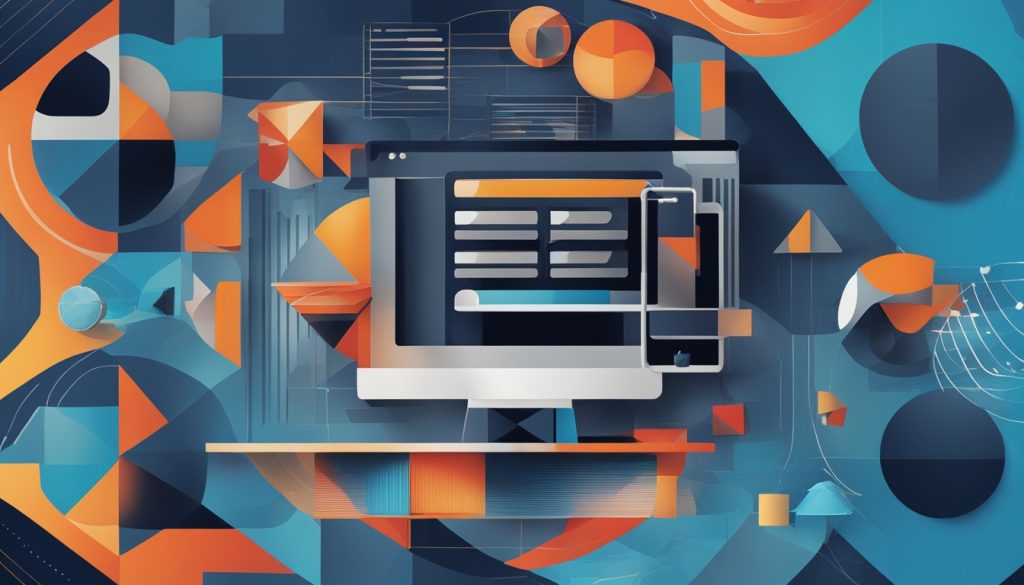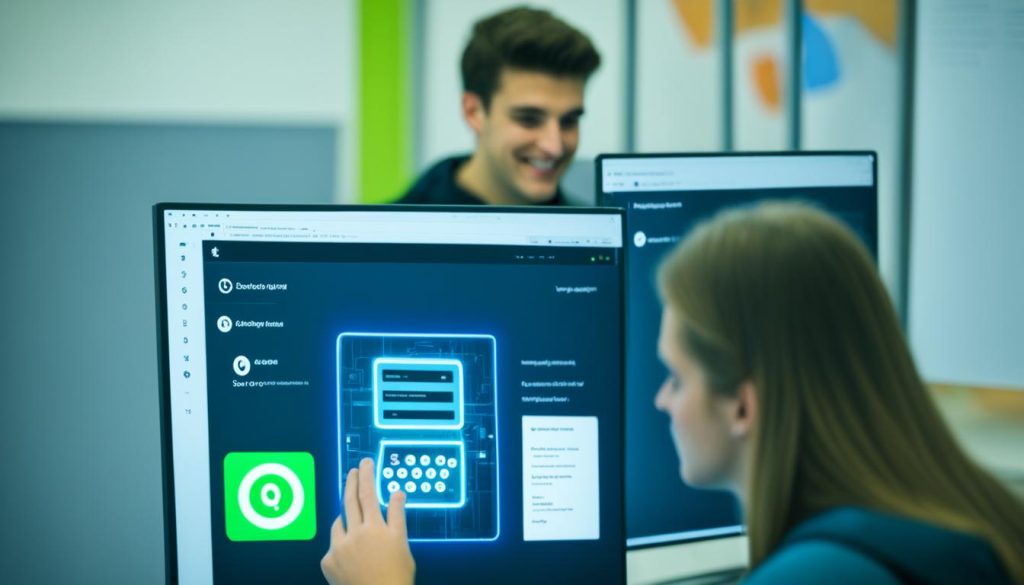How can schools make sure online learning is safe without limiting what students can learn? With online threats everywhere, having strong content filtering is key.
Creating a safe online space for learning takes careful planning. It means using content filters to keep students away from harmful websites. This not only keeps students safe but also helps improve teaching and learning.
It’s important to check digital content carefully. When schools pick their online resources with care, they create a supportive place for students to grow. This article will show you how to use content filtering well. It will use advice from top education tech sources and security experts. By the end, you’ll know how to keep your students safe and support their online learning.
Quick Recommendation: Our blog is filled with tips and tricks on computer monitoring and content filtering tools that enhance the safety of computer users from cyber threats, both for families and employers. If you are seeking the best tools and methods, we recommend SENTRY PC.
Understanding the Importance of Content Filtering
In today’s digital world, keeping students safe online is key. Content filtering is crucial in protecting them from harmful content and threats. It helps make the internet safer, supporting their well-being and learning.
Without filters, students face risks like seeing explicit content and facing cyber threats. Reports show 43% of school internet connections hit malicious sites every day. This highlights the need for strong filters to keep students safe and focused.
Also, students can be exposed to harmful online content that affects their mental health. Studies link such content to more anxiety and behavioral problems. By limiting access to only safe materials, students can learn better and stay healthy.

There are also laws that require schools to filter out harmful content. The Children’s Internet Protection Act (CIPA) demands that schools block sites that are bad for kids. These laws help keep students safe and support their well-being by blocking inappropriate content.
So, content filtering in schools is very important. It protects students from online dangers, keeps online resources suitable for learning, and follows the law. This makes the digital classroom safer and more effective for everyone.
Choosing the Right Content Filtering Solution
When picking the best content filtering software for your school, think about a few important things. First, it should keep up with new threats. Cyber threats change often, so your software must too to protect students from bad content.
It’s also key to have customizable safety features. Make sure the software lets you adjust settings for your school’s needs. This way, you can have different rules for different age groups or departments.
The vendor’s reputation matters a lot. Choose providers with a good history and positive reviews. Reliable vendors offer strong support and updates, keeping your software working well. Look at customer feedback and their reputation in the industry to see if they’re trustworthy and effective.

Quick Recommendation: Our blog is filled with tips and tricks on computer monitoring and content filtering tools that enhance the safety of computer users from cyber threats, both for families and employers. If you are seeking the best tools and methods, we recommend SENTRY PC.
Think about how easy it is to use and how much it costs. The platform should be simple for school admins to handle without needing a lot of training. It should also be affordable, giving you good protection without breaking the bank.
Lastly, consider if the solution can grow with your school. As your school gets bigger, the filtering software should too. It should keep protecting without needing a big change.
Looking at comparisons of content filtering solutions and guides on getting IT for schools can help you decide. Hearing from other schools about their experiences with these systems is also useful. Keep these points in mind to pick a content filtering solution that fits your school’s needs well.
Implementing Content Filtering with Minimal Disruption
Switching to a new content filtering system in schools can be tough. But, a phased rollout can make it easier. This way, you can spot and fix problems before everything goes live.
Training your staff is key to a smooth change. Make sure they know how to use and fix the new system. Include both how to use it and how to solve problems in the training.
It’s also important to keep everyone updated. Talk to teachers, administrators, and parents about the changes and when they’ll happen. This keeps everyone on the same page and working together.
Getting your network to work well with the new filter is crucial. Work closely with your IT team for this. Also, have a plan ready for when things go wrong to avoid long outages.

Schools like Oakwood High and Ridgeview Elementary have shown how to do it right. They rolled out the system step by step, trained their staff well, and made sure the network worked smoothly. Their stories can guide other schools to reduce problems during the switch.
Customizing Filters to Meet Your School’s Needs
It’s key to tailor your content filters to fit your school’s values and needs. Working with teachers and parents helps make sure the filters are right. This way, you keep content safe for students while making sure they can access important educational materials.

Begin by adding customizable options to your content filtering software. Create whitelists and blacklists with input from your school community. This ensures harmful content is blocked and important educational resources stay open.
Keeping an eye on your filters and updating them often is crucial. Check and adjust your filters to match school district policies on internet use. Use technical guides for content filtering software to help you customize effectively.
Studies show that schools that work with their community to set content standards get better at managing their filters. This teamwork leads to a safer, better learning space. It also helps students access the educational content they need.
Monitoring and Maintaining Content Filters
Keeping your school’s content filters working well needs a proactive plan. Regular audits help spot any weak spots in your system. These checks keep your network running smoothly and get you ready for cybersecurity risks.
It’s also key to keep your software updated. Installing updates right away makes sure your filters get the newest security fixes. Cybersecurity experts often share tips on how to do these audits, which can help your IT team a lot.
The world of cybersecurity threats is always changing, so you need to stay alert. Studies on cybersecurity in schools can give you tips on new threats and how to fight them. Keeping up with these studies and using their advice in your upkeep can really help protect your network.
Using special tools for ongoing checks can make sure your filters stay on top of new bad content. Software companies give logs on new security updates and improvements. Following these steps can make your content filtering much better and more reliable.
Balancing Accessibility and Security
Finding the right balance between giving students access to resources and keeping them safe online is tough for schools. It’s key to have clear rules about internet use. These rules help make sure students and teachers can get to the educational stuff they need. At the same time, they keep students away from harmful content.
Many schools have found a good way to balance this by working together. They talk to students, teachers, and experts to make their internet rules. This way, they make sure the rules work for everyone and keep the internet safe.
Some schools have set up systems where internet filters change based on what users say. This means students and teachers can get the resources they need without running into problems. Schools that do this keep their students safe and make sure they can learn well.
The Role of Training and Awareness
Training and awareness are key to making content filtering work well in schools. It’s important for students to know how to use the internet safely and responsibly. They need to understand why it’s important to act responsibly online and how to stay safe.
Teachers need support to enforce content filtering rules. Workshops and training can help them do this well. Working with tech experts can also improve digital safety efforts by offering new tools and strategies.
Adding digital citizenship to school lessons has worked well. It teaches students about digital safety from a young age. Studies show that students who know about digital safety act more responsibly online.
Successful awareness campaigns include interactive workshops and assemblies about digital safety. Teachers say these sessions help them teach students how to handle online issues better.
By focusing on training and awareness, schools can make the internet safer for everyone. This helps students and teachers use the internet responsibly and supports digital literacy.
Conclusion
Implementing a strong content filtering system is key to keeping students safe and creating a secure learning space. We’ve seen how vital content filtering is for a student’s digital safety. By choosing the right filtering solution, schools can protect students without limiting their access to information.
Customizing filters is crucial for schools. It’s about finding the right balance between security and the freedom needed for learning. Keeping an eye on these filters is also vital. This way, schools can quickly respond to new threats and keep their filters working well.
But it’s not just about the tech. Training and awareness are just as important. Educating staff and students about content filtering makes it a key part of school life. By keeping up with these efforts, schools can make sure their content filters work well. This helps protect students and makes learning safe for everyone.
Quick Recommendation: Our blog is filled with tips and tricks on computer monitoring and content filtering tools that enhance the safety of computer users from cyber threats, both for families and employers. If you are seeking the best tools and methods, we recommend SENTRY PC.

